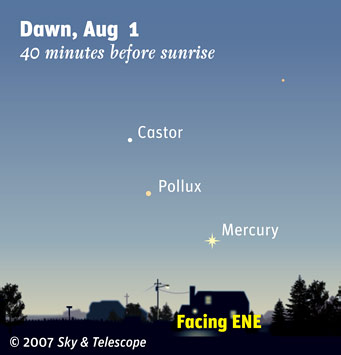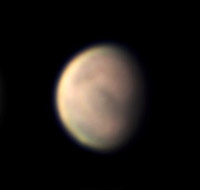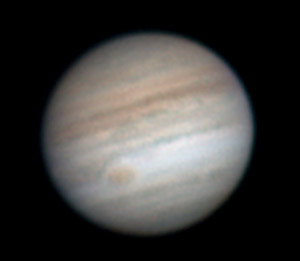Some daily events in the changing sky for July 27 – August 4.

Get up early this week before dawn gets too bright, and you can find Mercury shining above the east-northeast horizon.
Sky & Telescope diagram
Friday, July 27
Jupiter's moon Io reappears out of eclipse from Jupiter's shadow around 11:31 p.m. Eastern Daylight Time. With a small telescope, watch it swell into view just off Jupiter's eastern edge.
Saturday, July 28
Jupiter's Great Red Spot should cross Jupiter's central meridian (the imaginary line down the center of the planet's disk from pole to pole) around 9:06 p.m. EDT. The "red" spot, distinctly orange this year, should be visible for at least 60 minutes before and after in a good 4-inch telescope when the atmospheric seeing is sharp and steady.
Sunday, July 29
Full Moon (exact at 8:48 p.m. EDT).
Tonight, if you're in North America, you can track the eclipsing binary star SZ Herculis dipping from magnitude 10.5 to 12 and back. Make a timing! See the article, chart, and timetable in the July Sky & Telescope, page 58.
Monday, July 30
Jupiter's Red Spot transits around 10:44 p.m. EDT.
Tuesday, July 31
Jupiter's moon Europa casts its very tiny black shadow onto Jupiter's face tonight from 9:35 p.m. to 12:09 a.m. Eastern Daylight Time.
Wednesday, August 1
In the summer (the Northern Hemisphere's summer, that is), Orion's opposite number as a big-guy constellation who begins with O stands, Orion-like, in the southern sky. That would be Ophiuchus, the Serpent Holder. This year Jupiter is tangled up in his dim feet. Piece out Ophiuchus, and find some of his binocular and telescopic sights, using Fred Schaaf's columns in the July and August issues of Sky & Telescope, pages 42 and 34, respectively.
Thursday, August 2
Jupiter's Red Spot transits around 8:14 p.m. EDT.
Tonight North Americans have another chance to time an eclipse of SZ Herculis. See Sunday's item above.
Friday, August 3
Taking a dip in the water these August evenings? This is the season when the Big Dipper dips properly dipper-like in the sky, scooping star-water in the northwest after dark.
Saturday, August 4
Jupiter's Red Spot transits around 9:53 p.m. EDT.
Want to become a better amateur astronomer? Learn your way around the constellations. They're the key to locating everything fainter and deeper to hunt with binoculars or a telescope. For an easy-to-use constellation guide covering the whole evening sky, use the big monthly foldout map in each issue of Sky & Telescope, the essential magazine of astronomy. Or download our free Getting Started in Astronomy booklet (which only has bimonthly maps).
Once you get a telescope, to put it to good use you'll need a detailed, large-scale sky atlas (set of maps; the standard is Sky Atlas 2000.0) and good deep-sky guidebooks (such as Sky Atlas 2000.0 Companion or the enchanting though dated Burnham's Celestial Handbook). Read here how to use them most effectively.
More beginners' tips: "How to Start Right in Astronomy".
This Week's Planet Roundup
Mercury, brightening from magnitude 0 to –1, is having a fine apparition low in the glow of dawn. Look for it above the east-northeast horizon about 45 to 60 minutes before sunrise, very far below Capella. Nearby are fainter Pollux and Castor, as shown at the top of this page. Bring binoculars to look for them. (To find your local sunrise time, and much else, make sure you've put your location into our online almanac. If you're on daylight saving time like most of North America, make sure the Daylight Saving Time box is checked.)

There's still dust-storm activity on Mars. In this July 26th image, the dark band from center-right toward top left is the familiar Sinus Sabaeus / Sinus Meridiani region. But it seems partly obscured by unfamiliar bright marks. North is up. Click the image to see the separate blue, green, red, and near-infrared images that went into this composite.
S&T: Sean Walker
Venus (magnitude –4.3) is fast disappearing into the glare of sunset.
Mars (magnitude +0.5, in Taurus) rises around 1 a.m. daylight saving time is and high in the east by dawn. Look for the Pleiades to its left, and Mars-like Aldebaran below the Pleiades.
In a telescope Mars is currently only 7 arcseconds in diameter, but it's on its way to a Christmas-season opposition, when it will grow to nearly 16 arcseconds wide in the evening sky. This will be a far cry from the 25
th it displayed at its record-breaking close approach in 2003 — but it'll be the largest Mars will appear again until the opposition of 2016!
Incidentally, if friends or family tell you they hear that Mars will become as big and bright as the full Moon in the next few weeks, be nice to them. Read our article about the regular-as-clockwork August Mars Hoax, so that you can tell them the whole story. (My comment about immunization is optional.)

Jupiter is receding a bit farther into the distance, so detail on it is getting harder to see and image. Click the picture for a series of three views showing the planet's face changing due to rotation in less than three hours.
S&T: Sean Walker
Jupiter (magnitude –2.5, in southern Ophiuchus) glares in the south during twilight and lower in the southwest later after dark. Antares, less bright, sparkles redly 5° below it; the two are evening companions all summer. Other stars of Scorpius shine below them and to their right.
Saturn is lost in the sunset.
Uranus (magnitude 5.8, in Aquarius) and Neptune (magnitude 7.8, in Capricornus) are well up in the south during early morning hours.
Pluto (magnitude 13.9, in the northwestern corner of Sagittarius) is highest right after dark, 18° east-northeast of Jupiter. Finder charts for Uranus, Neptune, and Pluto are in the July Sky & Telescope, page 60.
All descriptions that relate to your horizon — including the words up, down, right, and left — are written for the world's midnorthern latitudes. Descriptions that also depend on longitude (mainly Moon positions) are for North America. Eastern Daylight Time (EDT) equals Universal Time (UT, UTC, or GMT) minus 4 hours.
To always get the up-to-date Sky at a Glance, bookmark this URL:
http://SkyTonight.com/observing/ataglance .
"Rational and innocent entertainment of the highest kind."
— John Mills, 19th century Scottish manufacturer and founder of Mills Observatory, on amateur astronomy.


 0
0

Comments
You must be logged in to post a comment.